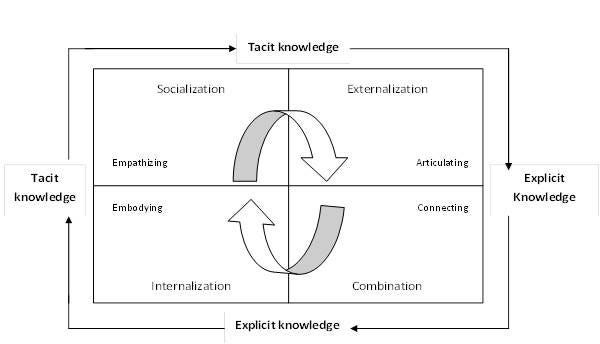The Spiral of Knowledge
Converting what your people know into what makes your company successful.
The number one skill an organization needs to develop in this era of super-information processing is the ability to turn tacit knowledge into explicit knowledge.
“I don’t know how I know. I just do.”
How many times have you heard that at work when asking someone how to do something? It happens all the time. As humans, we mostly operate on a default mode of action that is highly personal and cognitive. This mode of action consists of mental models, beliefs, and perspectives so ingrained in us that we don’t even realize we’re using them to make decisions.
Think back to when you learned to tie your shoes. It was a mind-bender at first, but now you don’t even think about it. Now think about your job. Remember when you first started? How everything felt foreign and had to be learned? And now? I bet you’re a well-oiled machine who can do most of it in your sleep.
Ikuko Tanaka, a software developer from Japan’s Matsushita company (which later became Panasonic), realized this and came up with an ingenuous method of innovation to help her company create a breakthrough home bread-making machine in the early 80’s.
This is her story and the story of converting tacit knowledge into explicit knowledge.
Kneading An Answer
Matsushita set out to revolutionize the world of home breadmaking in 1984. They combined three divisions into one and set out to work.
Their first attempt was a miserable failure.
The crust was overcooked. The inside was raw. They even X-rayed the bread! But no meaningful data was found for the team working on the project. Then Tanaka had an idea. The Osaka International Hotel was famous for its bread.
Tanaka apprenticed the head baker to figure out what he knew that could be used in designing the machine.
“I ate 5,000 pieces of bread in those 3 years!” - Ikuko Tanaka
In consuming all that bread and watching what the head baker was doing, she noticed something.
“I was watching the master to steal the way he kneaded the dough and tried it myself. He not only slaps, but also ‘twists and stretches’ the dough. When I found it, I went straight to the hardware engineer and talked about it.” - Ikuko Tanaka
The hardware engineers created a piece in the machine that trapped rotating dough, mimicking the ‘twist and stretch’ Tanaka had witnessed. The results followed. 536,000 units sold in the first year. Exports all over the world. Inspiration for new divisions throughout the Matsushita company. It was a wild success.
The Baker’s Brain
What the head baker at the Osaka International Hotel had was an assumed knowledge of how to bake the perfect loaf of bread. Twisting and stretching was just one part of it. It happened to be the key to unlocking Matsushita’s machine, but this highlights a challenge of tacit knowledge - we can’t “know it” from an outside perspective. We don’t know what is relevant and what is not at any given moment. We just do it.
It Takes Two To Tandoor
To convert our tacit knowledge into explicit knowledge, we need the help of other people. This is the first step in the SECI model of knowledge creation, developed by Ikujiro Nonaka in 1990 - Socialization.
Tanaka developed empathy for how the head baker performed his craft, and as a result, she picked up on the nuances. But had this cycle stopped there, no one at Matsushita would’ve gained systematic knowledge about making the breadmaking machine.
Here’s What I Saw
What Tanaka was able to do was explain what she saw to the hardware engineers. This Articulation step was crucial in externalizing the tacit knowledge she had gained for others to understand. Now we have momentum in the spiral of knowledge!
Everything Is A Remix
Kirby Ferguson’s viral idea that everything is a remix is apt to describe what happened next. The hardware engineers ran with the twists and stretches of the dough as part of a larger mechanism at work in the machine. The result was flawless homemade bread. This step of connecting is called Combination. The next and final step completes the cycle and elevates knowledge creation to a new level.
Spiraling Up
As Tanaka and her team created the new product, so they enriched their tacit knowledge bases even further. When employees invent new knowledge, they reinvent themselves, the company, and even the world. Through this step of Internalization, they embodied their vision of the world: that homemade machine bread should be as good as bread baked by professionals.
Expressing the Inexpressible
Converting tacit knowledge into explicit knowledge and back into tacit knowledge at the organizational level means finding a way to express the inexpressible, just like Tanaka did in pinpointing what the head baker was doing that they were missing. Fortunately, the Japanese have figured out a method that works. Unfortunately, it’s among the most frequently overlooked management tools.
I’m talking about the store of figurative language and symbolism that managers can use to articulate complex ideas or intuitions.
Stay tuned. The next time you hear from me, we’ll explore exactly how to use it.
p.s. this post was heavily influenced by the work of Ikujirō Nonaka and his book, The Knowledge-creating Company.





